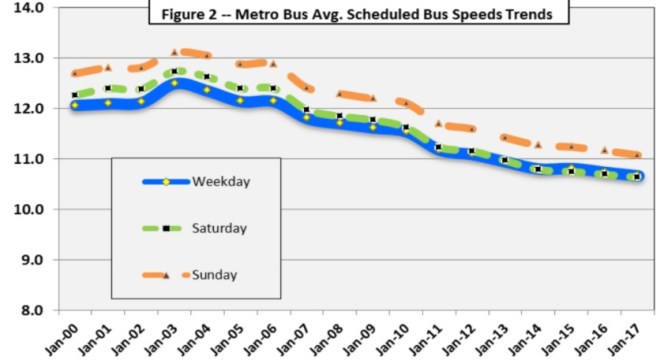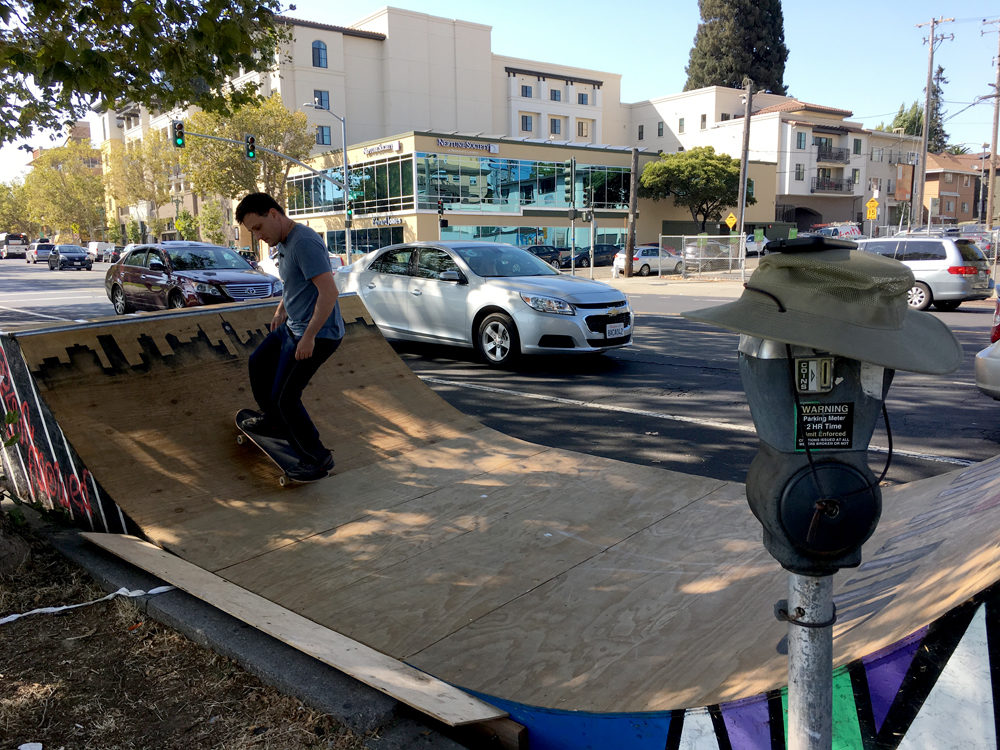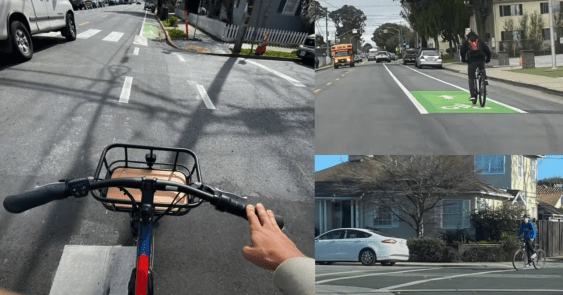In some corners at Metro, there is an underlying narrative that safety and livability improvements are in conflict with transit operations.
Metro representatives occasionally blame declining bus performance on traffic calming, and other walkability/bikeability improvements. In a March 2016 KPCC interview about buses' declining on-time performance, Metro spokesperson Bob Holland blamed "recent construction" and "a number of other factors, including heavier traffic and road diets." The perceived conflict surfaces in official Metro comments in environmental studies, for example see Master Comment 34 here.
This week the sentiment resurfaced in writing and in person. A Metro staff report (excerpted on Twitter by Laura Nelson) discussed factors causing declines in bus system speed and on-time performance. The report starts by citing an overall increase in traffic congestion, then goes on to state:
Cities have inaugurated a variety of programs to calm traffic - which restrict flow. For example, the City of Pasadena is attempting to create a more pedestrian friendly zone along Colorado Boulevard, reducing lanes for traffic and encouraging walking and bicycling instead. These restrictions hamper bus movements in particular and either force bus routes to shift away from the desired destinations of bus riders or create greater inconvenience for those that use transit. The City of Los Angeles has created a number of these zones on Broadway and is proposing to do so on other traditionally heavy bus transportation corridors, e.g. Soto Street.
Note that while neither Pasadena's Colorado Boulevard nor L.A.'s Soto Street actually have any lane reductions on the ground yet, Metro bus speeds have declined: "since 2003 the average speed on our bus system has declined between 15 and 16 percent" (per the same staff report.)
(A brief digression on Soto Street, which has no bike lanes, despite lanes being approved there in the city of L.A.'s 1996 bike plan, 2011 bike plan, and in the Bicycle Enhanced Network in Mobility Plan 2035 approved in 2015. In 2014, as part of its "Second Year" batch of bike lanes, LADOT made an effort to add bike lanes to Soto. LADOT held community meetings, did expensive environmental clearance studies, then implemented nothing. Meanwhile, according to the city's Vision Zero map, since 2003 eight people were killed in crashes along Soto, so the city recently identified Soto as a Vision Zero priority corridor.)
At yesterday's first meeting of the new Metro Ad Hoc Customer Experience Committee, there was a noteworthy exchange where L.A. City Councilmember and Metro Boardmember Mike Bonin sought to disabuse Metro Deputy Executive Officer Gary Spivack from pitting buses against Vision Zero: (For audio, listen at item 41, minute 1:13 at Metro meeting website)
Spivack: ...one of the things that we have been talking about over the last several years is the decline in our bus speeds. The simple matter of it all is basically that as our speeds decline we need to continue to put out more resources just to stay where we are. ...increased traffic congestion has led to declining bus speeds.
We are talking about traffic calming solutions. We are in a collision course with cities and localities who want to deal with pedestrian incidents, make it safer for people to cross streets, but also it works in conflict, and one of the things that we need to do in developing this work that we’re talking about here is to come to a balance between Vision Zero, Great Streets, and also the other types of issues so that bus streets and bus corridors can also provide faster quicker service -
Bonin: Oh hold on. Let me just challenge that. I need to challenge that, because I think if there’s an idea in this agency that needs to be smashed it’s that one, about “there’s a conflict between Vision Zero and making the system work well.”
First of all, the number of places in Los Angeles that have traffic calming is probably one percent of our network, if that. So that you cannot suggest Vision Zero is responsible for our problems with speed and on time service
The second is - I think that if there is a concept that this committee is going to try to advance is that the passenger experience begins the moment you walk out the door of your apartment to the moment you walk in the door of your destination. If you have a greater chance than you would in other places of getting severely injured or killed on the way to the bus, that has a fundamental impact on whether or not you’re willing to use the service in the first place. [Bonin later clarified that his language had not been as inclusive as he intended, as some people with disabilities would not be walking, but his overall point remains valid.]
I think we as an agency - just as Mr. Washington was talking about: we need to think multi-modally - one of the fundamental elements of that is the pedestrian experience. People don’t magically appear at our bus stops or our train stops. They have to get there safely. There are a number of Vision Zero projects, things in the Mobility Plan that are also looking to provide Bus Rapid Transit in certain areas. These all have to go together.
I’m sorry to interrupt but I just couldn’t let that concept that traffic calming is somehow harmful to the holistic system serving well to stand.
Spivack: I understand. And I wasn’t really -
Metro CEO Phil Washington: Let me just say that that’s not the official opinion of the organization.
Bonin: Thank you.
Spivack: Let me clean that up a little bit as well. I wasn’t trying to say that traffic calming is the cause of issues, but we have a variety of plans that have put us in conflict. For example on Soto Street a plan is being advanced to do traffic calming and reduce the traffic lanes. That will have a severe impact on the operation of two of our major bus lines, a rapid line as well as a local line. My comment was really to say we need to get in there and work with the city so that we can benefit both or at least offset some of the speed and reliability issues.
Spivack went on to clarify that overall, throughout the six-county Southern California Association of Governments region, auto sales are up and vehicle congestion is increasing, which contributes to bus delays. Spivack and Bonin agreed on solutions including signal preemption and all-door boarding.
The upshot of the discussion is that Metro will proceed with developing a plan to improve bus speed and on-time performance on key corridors. This will include identifying ten key transit corridors, then, for each corridor, finding "traffic signal, transit priority, and operational solutions" to improve bus performance.
Given that Metro's bus budget has remained flat for years, and that driving is recently on the increase (probably due to an economic upturn coupled with low gas prices), Metro operations staff face a heroic task to provide reliable bus service, much less to maintain or increase ridership. Pitting transit riders against traffic safety, especially for vulnerable road users including pedestrians and cyclists, may sound tempting, but ends up resulting in squabbles between parties who should have a great deal of common ground.






